


Okamoto's earliest work includes the classic Konami space shooters Time
Pilot (1982) and Gyruss (1983).
1942 also began life as a space shooter - but this changed in August
1984 after the developers went to see 'Zerosen Moyu', a movie about WWII
fighter planes.
1942 was Capcom's first game made with Western markets in mind, which is
why you pilot an American Lockheed P-38.
Every fourth level is based on a historic air battle from WWII. The
player's mission of reaching Tokyo and destroying the Japanese air fleet
garnered some domestic criticism.
Power-ups range from wider shots to Galaga-inspired flanking fighters. A
novel feature is the barrel roll escape move, which can be converted
into end-of-stage bonus points, if unused.
Okamoto continued his string of hits with Gun.Smoke (1985), Final Fight
(1989), and Street Fighter II (1991).
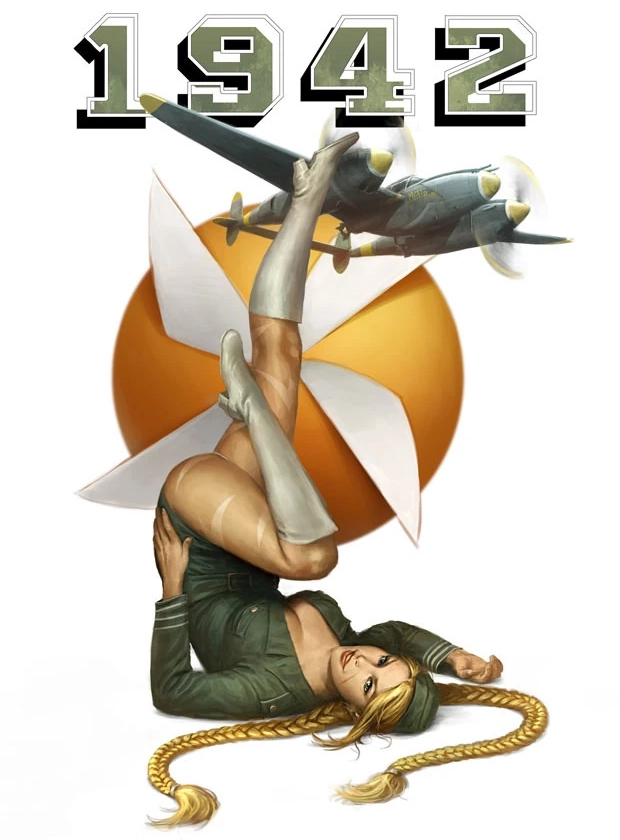
Capcom's ubiquitous Yashichi bonus icon
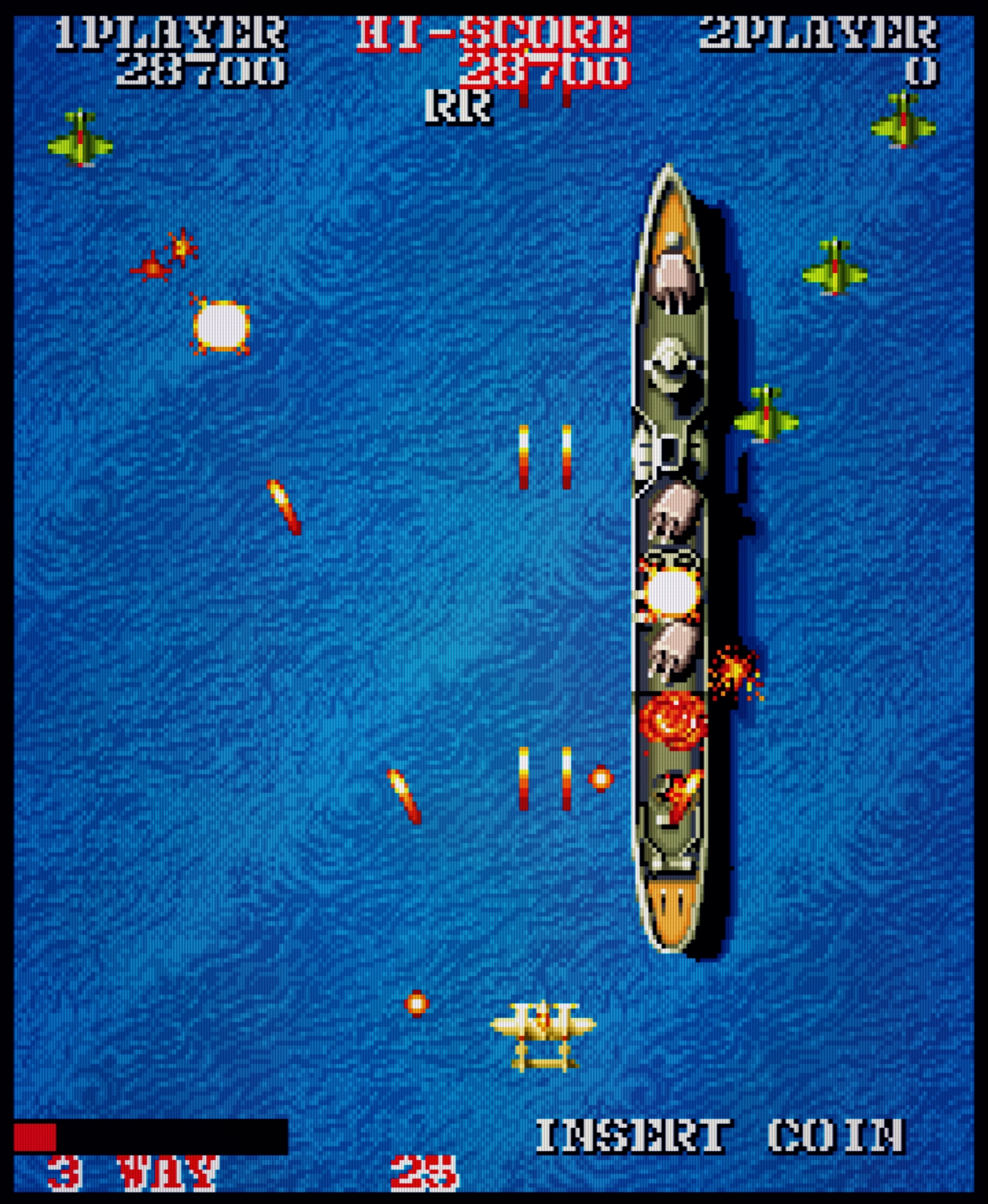
1943: The Battle of Midway
1942 was Capcom's first big arcade hit, spawning several 194X
follow-ups.
1943: The Battle of Midway (1987) improved on almost everything:
graphics, sound, power-ups, and gameplay variation.
But the sequel is also more frantic and boss fights quickly devolve
into button mashing, although this can be mitigated by clever choice
of weapon.
In comparison, 1942 always puts the player in a state of zen -
relying on precision and memory to improve the hit-to-miss ratio.
The urge to shoot down entire squadrons for bonus points and
power-ups is an addictive but risky meta-game.
The first two games in the series were incredibly popular in Denmark
and featured in every arcade and on most ferries.
My respective high scores are
541,280 points
on 1942, and
479,540 points
on 1943: The Battle of Midway.
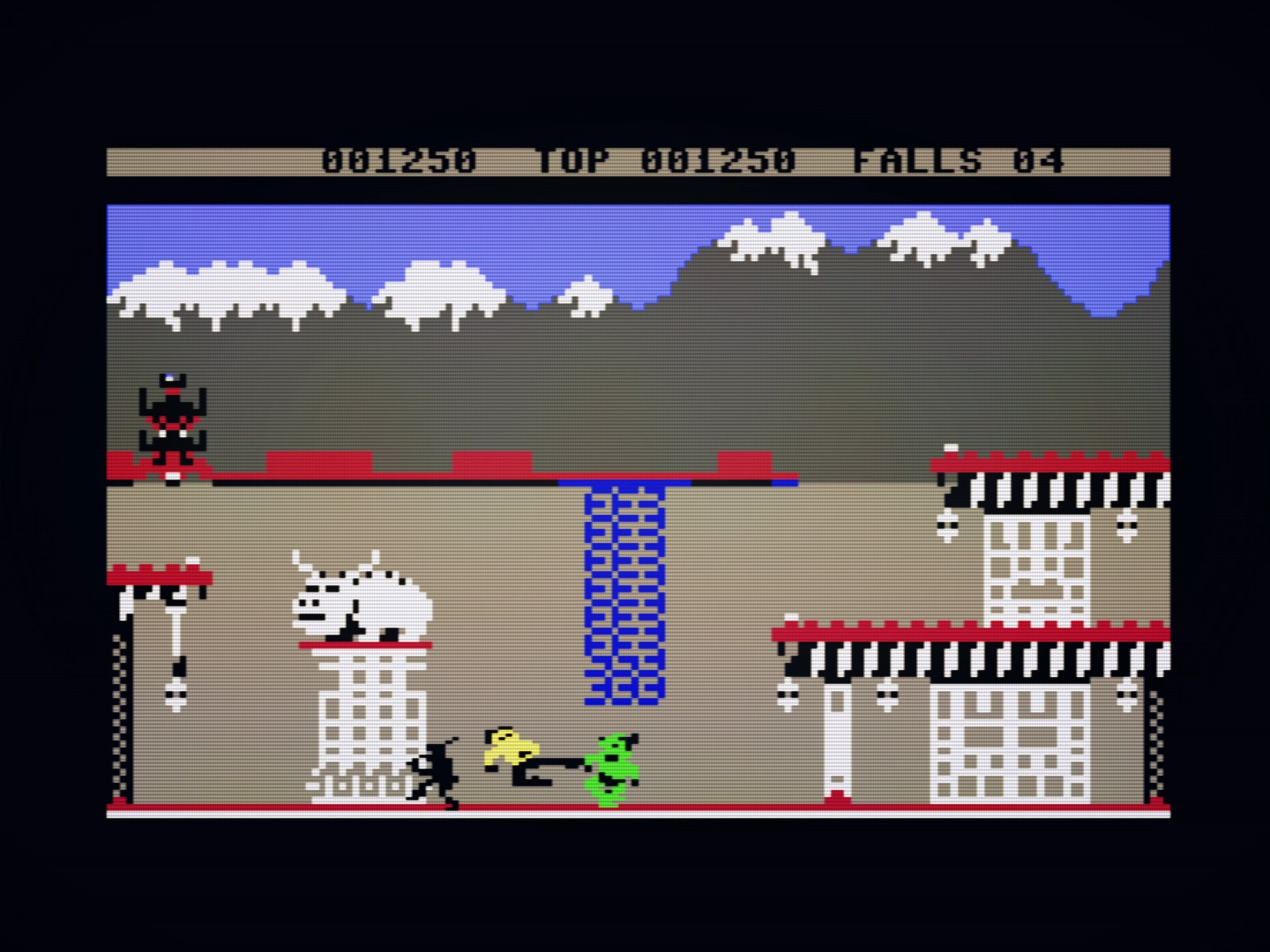
If you owned an 8-bit computer, you most likely had a copy of Bruce Lee,
one of the most iconic games of its time.
Developed for the Atari 8-bit family by Ron J. Fortier, with additional
design and graphics by Kelly Day. They converted it to the superior C64
(shown) in a couple of months.
You control Bruce Lee as he fights through twenty screens into the
wizard's fortress. A ninja and a green sumo wrestler named Yamo try to
beat you up, as you pick up lanterns to unlock the next screen.
The game features a hotseat mode and a simultaneous 2P mode, where
player two takes control of Yamo.
Bruce Lee was released to rave reviews and praise for its groundbreaking
beat 'em up platforming.
The main criticism was the easy difficulty, due to DataSoft's president
being unable to complete it during testing.
This was somewhat alleviated by the second run having the enemies spawn
instantly and removing certain safe spots.
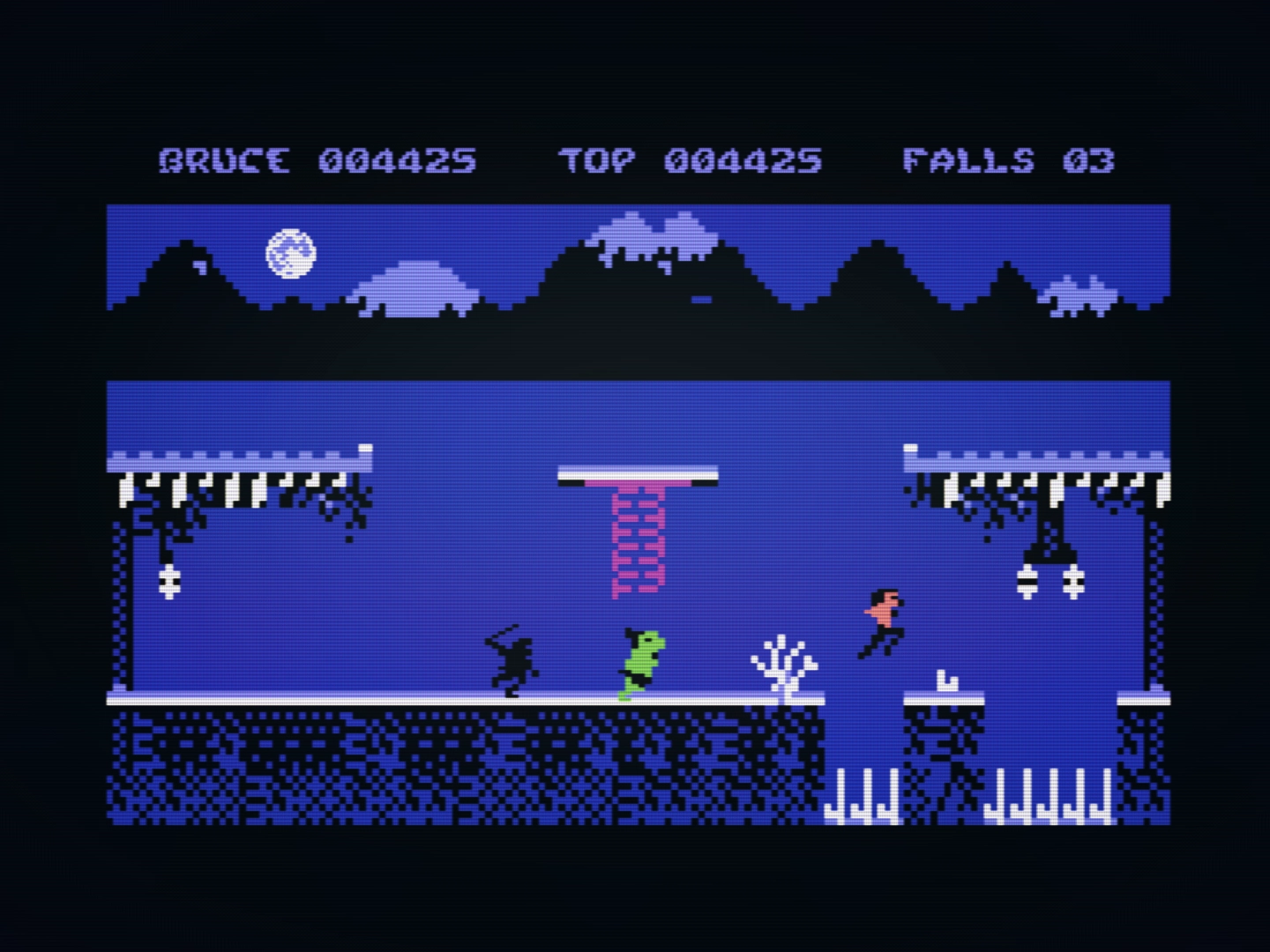
Bruce Lee: Return of Fury+, fan release, 2019
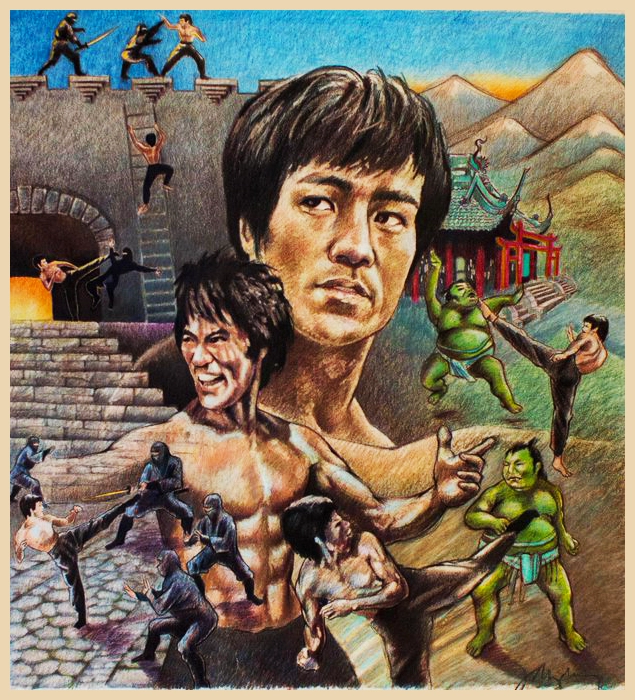
Original cover art sketch
Although Bruce Lee's popularity had peaked in the 1970s, his persona
was a perfect fit for a computer game in the 1980s.
DataSoft reached out to Ziv International, a third party license
company, who secured a deal with Bruce's widow, Linda.
The bright yellow skin color on the C64 didn't seem to bother the
estate of Bruce Lee, but the notion of 'Lives' did. At the behest of
Linda Lee, they were changed to merely 'Falls'.
On a personal note, my family had an acquaintance who grew up with
Bruce Lee in Kowloon Tong, Hong Kong. Naturally, none of the kids in
my school believed me back then!

In H.E.R.O. (Helicopter Emergency Rescue Operation) you're tasked with
rescuing trapped miners.
You don't need to get the miners out; just high-five them to collect
your bonus, which is based on the power left in your helipack.
Rock walls can be demolished using a finite supply of dynamite. Same
goes for the magma walls, but they'll kill you if you come too close, as
will standing too close to the lit stick.
Run out of explosives and you'll have to rely on your slow, forward
firing laser and risk running out of heli power.
Use your laser to kill deadly spiders, bats, moths, and snakes.
Break a lamp, and the screen turns black and grey - a novel touch that
makes it much harder to navigate the labyrinthine caves.
Avoid the poisonous groundwater and use the raft to cross certain
sections. Avoid the tentacled monster lurking in the water on later
levels.
Zzap! magazine said about the C64 version (shown): "H.E.R.O. looks
awful, sounds terrible, but plays absolutely beautifully."
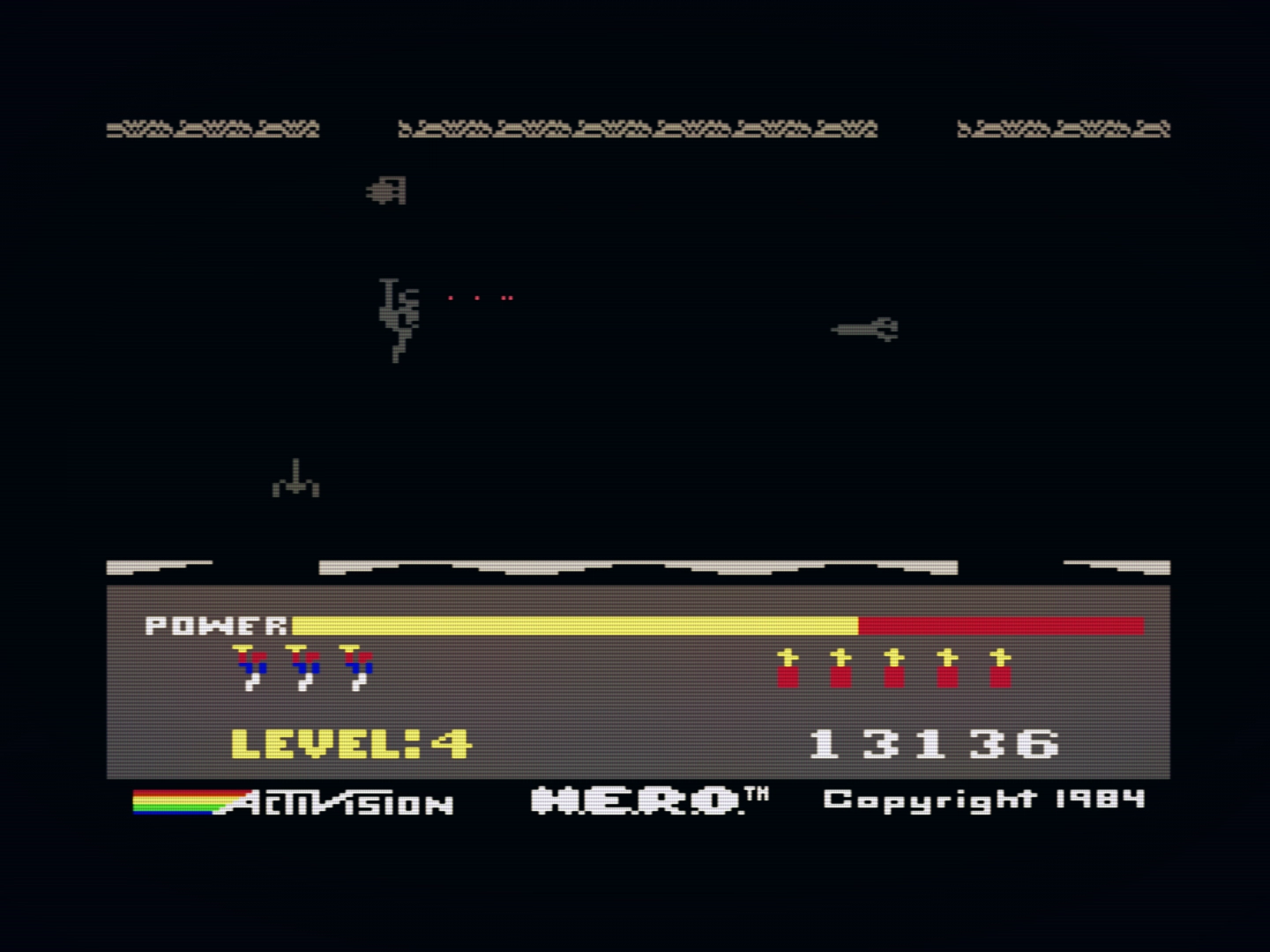
'Duh, who put the lights out?'
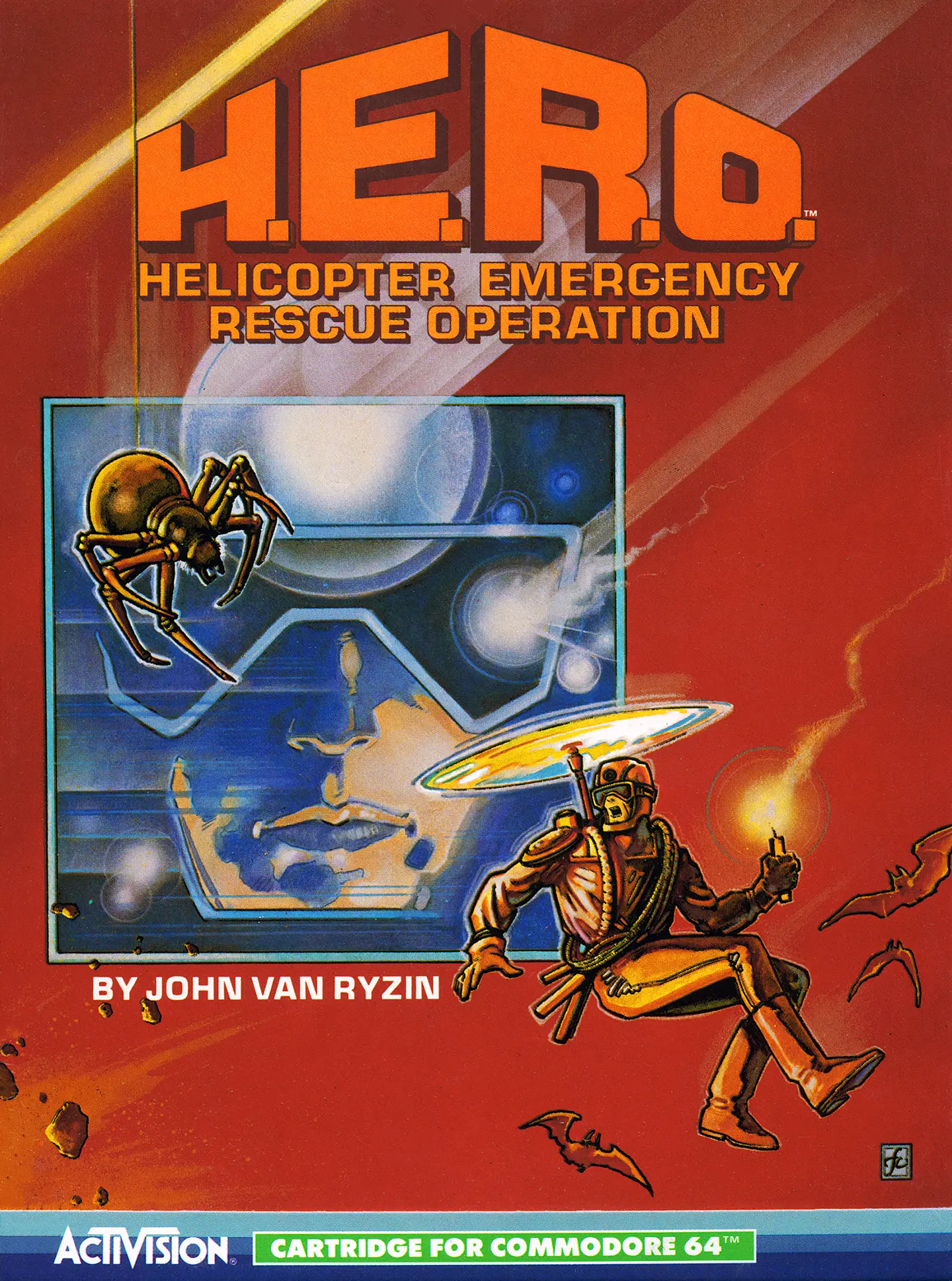
Revised cartridge box art
Van Ryzin didn't care for the original, goofy cover art, so it was
revised for the cartridge release.
H.E.R.O. is a dexterity test where inertia and gravity are your
biggest enemies.
Pixel perfect timing is crucial when passing through moving magma
walls and getting off rafts.
For every 20,000 points, you're awarded an extra life - up to a
maximum of seven.
Focus on the time bonus, learn the best routes, save your dynamite,
and only kill enemies in your path.
My high score on the C64 version is 181,690.
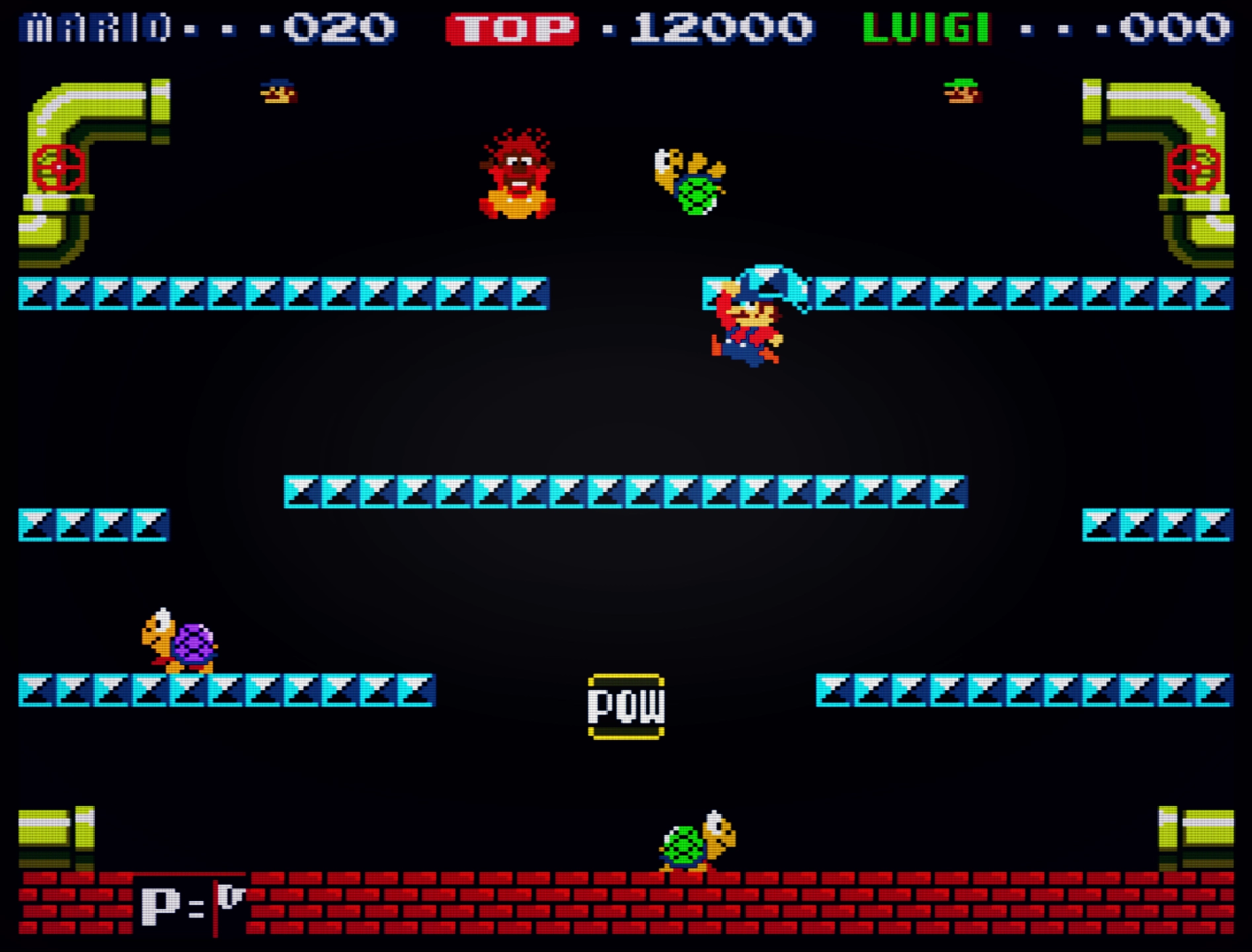
While Williams's Joust (1982) influenced the design of Mario Bros.,
Miyamoto and Yokoi, who previously worked on Donkey Kong (1981), added
several original ideas.
Mario Bros. was the first game to use 'Mario' in the title, the first to
cast him as a plumber, the first to feature his brother Luigi, spinning
coins, pipes, flippable turtles, and POW blocks.
Unlike the later Super Mario Bros., you flip over enemies by jumping
into them from beneath a platform, then kicking them to score points.
The POW block flips all on-screen enemies - a double-edged sword, since
already flipped enemies will come alive again.
Bonus rounds consist of grabbing as many spinning coins as you can
before a timer runs out.
Nerd alert: Game & Watch Mario Bros. was technically speaking first to
use 'Mario' in the title and to feature Luigi.
However, the arcade version was developed first, but
released three months after the disparate Game & Watch title.
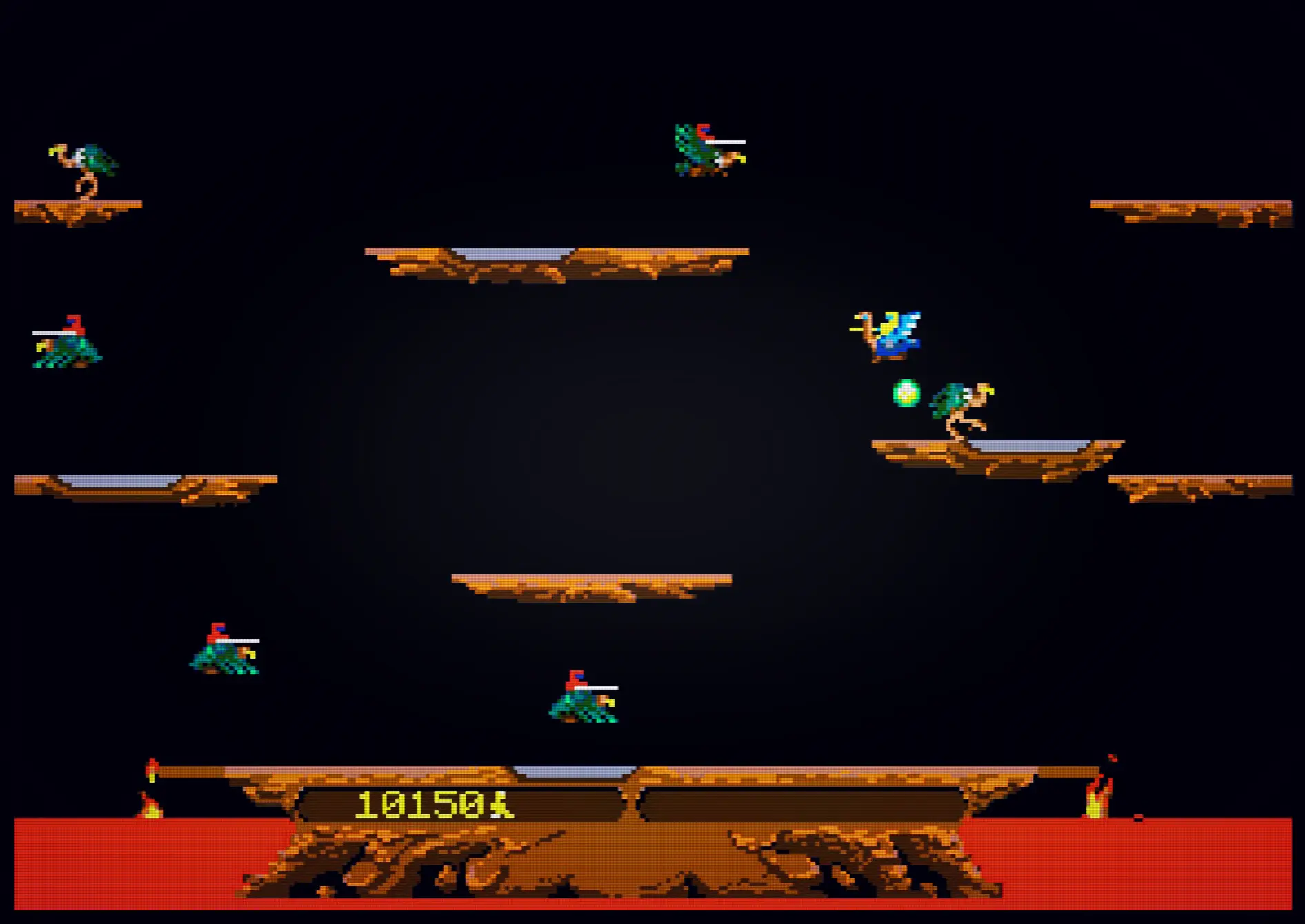
Joust (Williams, 1982)
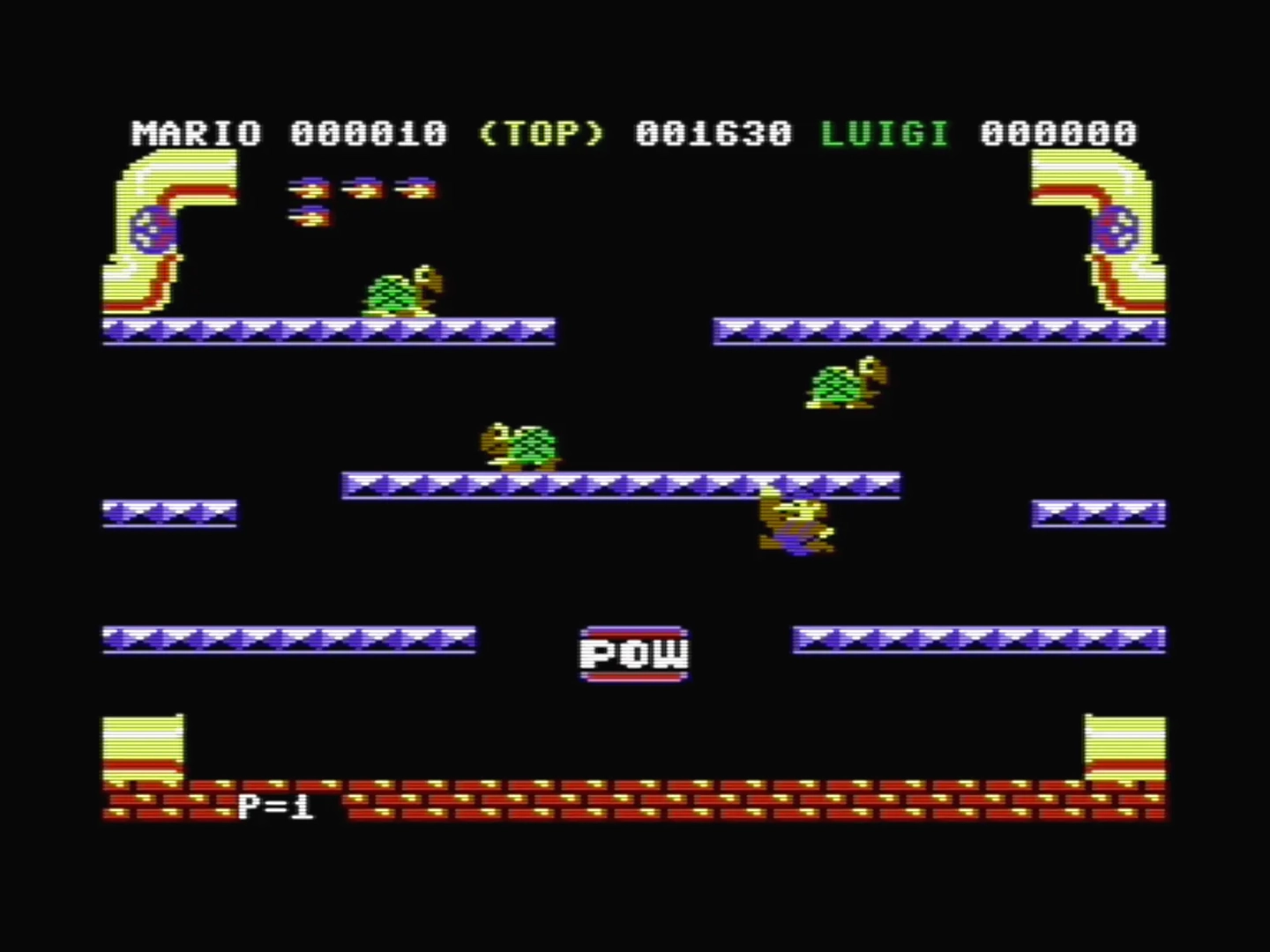
C64 version (Atarisoft, 1984)
As a boy, I preferred the excellent C64 Atarisoft version to the
1987 Ocean one.
Hilarity ensued from feigning cooperation with a friend, then
griefing each other instead.
In 2P mode you can bounce the other player into an enemy or down a
platform - or re-flip an enemy, just as your friend tries to score
points.
Activate the POW block to tease or kill the other player by
reanimating flipped enemies or provoke a mistimed jump.
When a bonus stage begins, it's a free-for-all coin-grabbing
competition!
Bonus info: The intro ditty is from Mozart's "Eine kleine
Nachtmusik".
My high score on the arcade is
89,330 points.
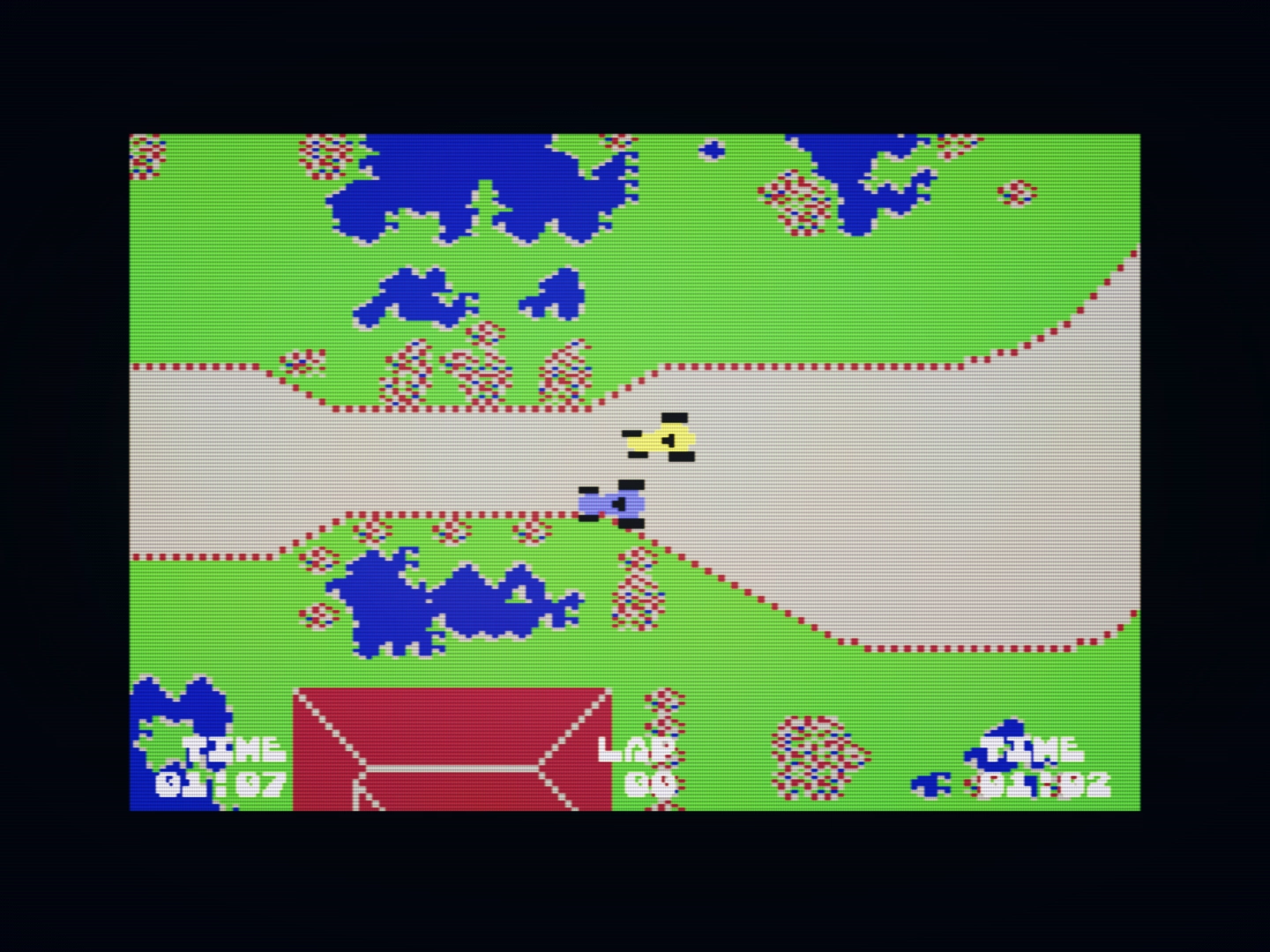
Rally Speedway is an unashamed reproduction of the Intellivision game
Auto Racing (1980). However, the improvements warrant Rally Speedway's
own place in gaming history.
Rally Speedway was first released for the Atari 8-bit series and
subsequently published by Commodore for the C64 (shown above) in
December 1984.
Andrew Graham, the developer of Micro Machines (1991) for NES, cites
Rally Speedway as his inspiration: the top-down view, penalties for
falling behind, and the control method - although all of these ideas
actually originated in Auto Racing.
Anderson's original contributions consisted of adding chicanes, an
intuitive track editor, and optional gameplay settings; importantly, he
also turned the concept into a fast and smooth experience in a mere 16
kilobytes.
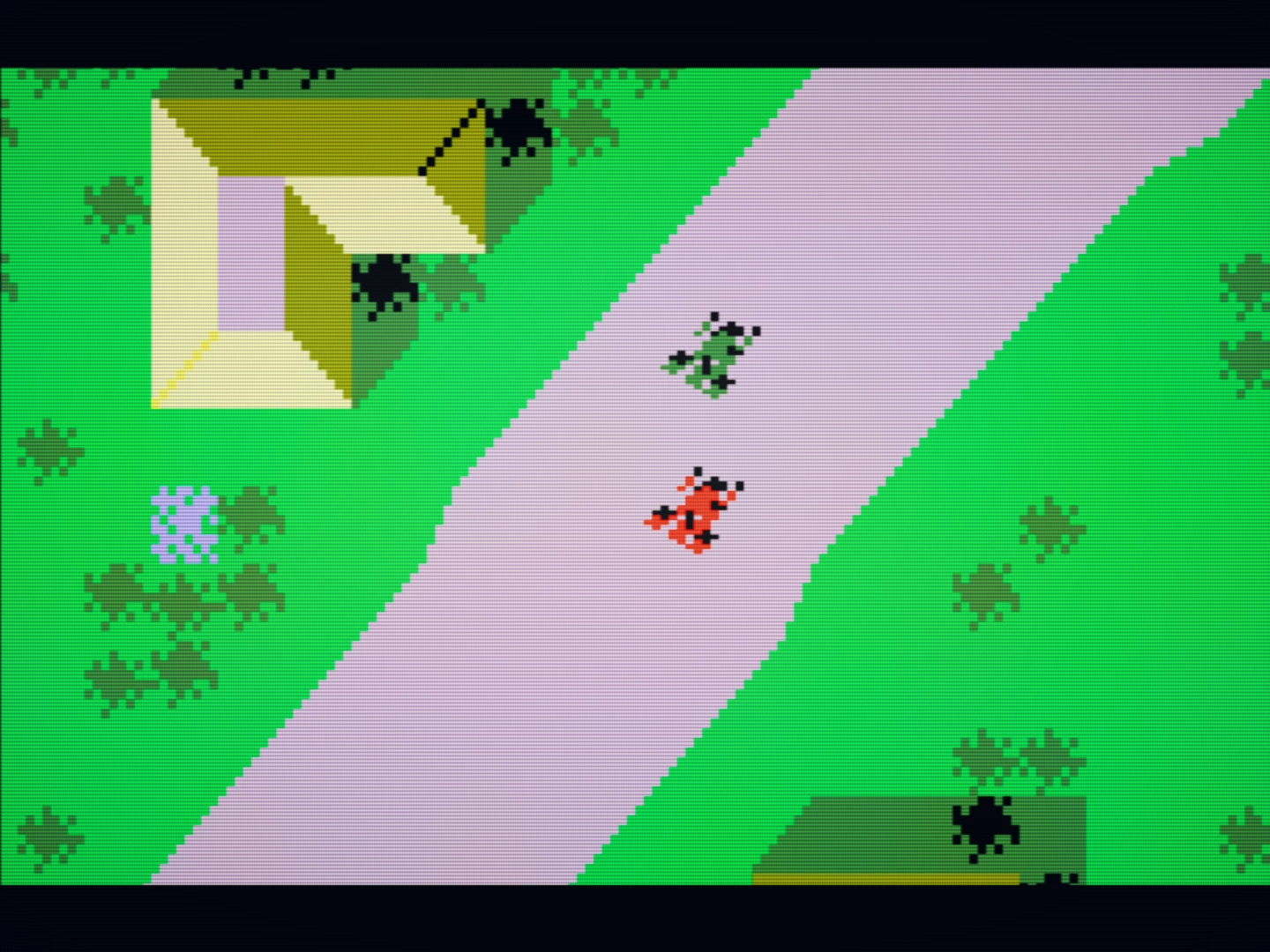
Auto Racing by Larry Zwick
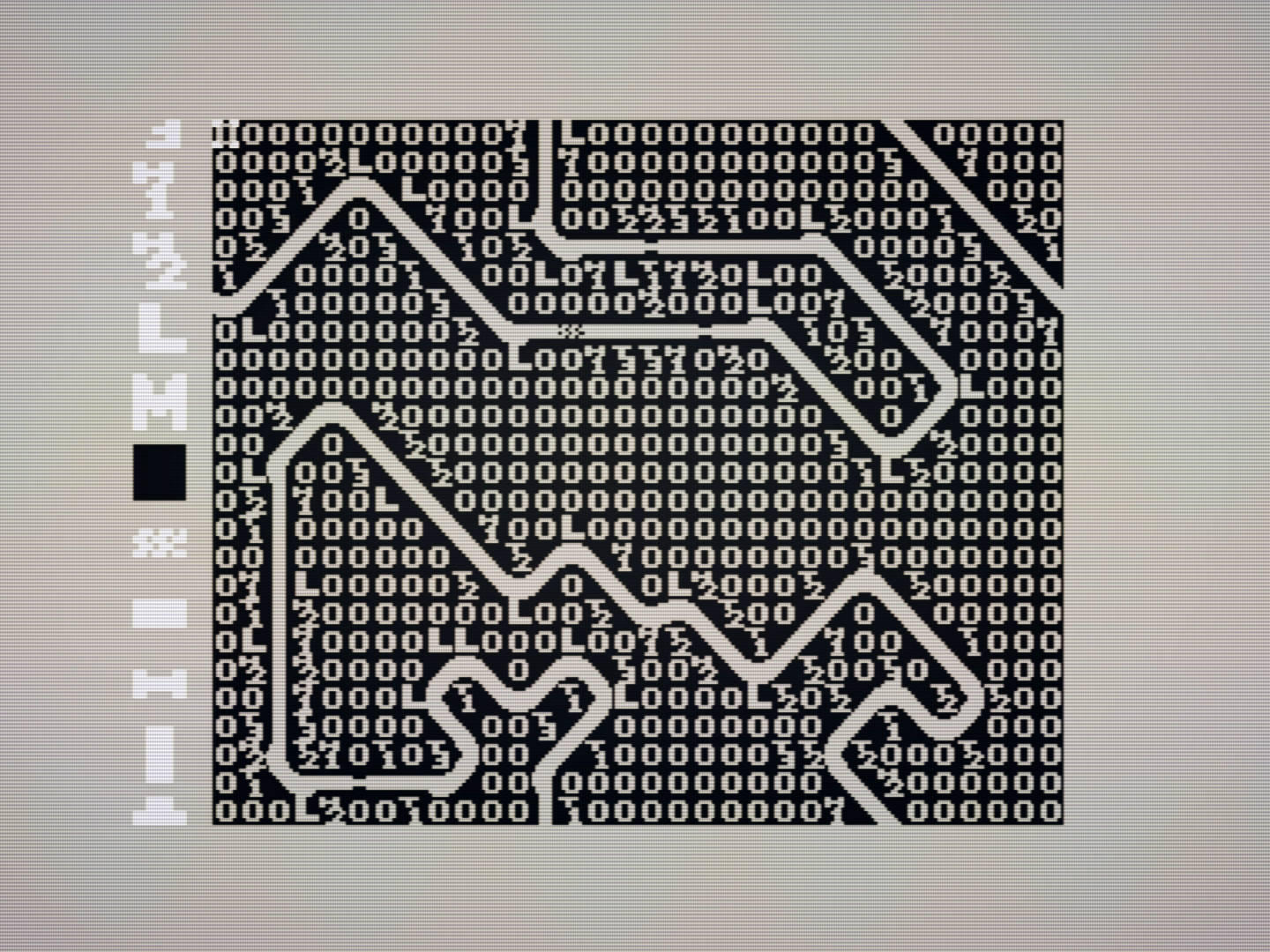
Rally Speedway's built-in track editor
While the 1P mode in Rally Speedway is a dull race against the
clock, the 2P mode turns things into a hillarious bumper fight or a
thrilling game of chicken: who will brake first into the next
hairpin turn at top speed?
This formula has been succesfully copied countless times, with or
without added weapons: Rally Cross (1989), Super Cars (1990), Nitro
(1990), Micro Machines (1991), ATR: All Terrain Racing (1995),
Mashed (2004), Retro Racing (2019), and more.
Both Super Cars II and Micro Machines V3 will feature on this page
in the future.
The charm and simplicity of Rally Speedway makes it easy to pick up
and fun to play, even today.
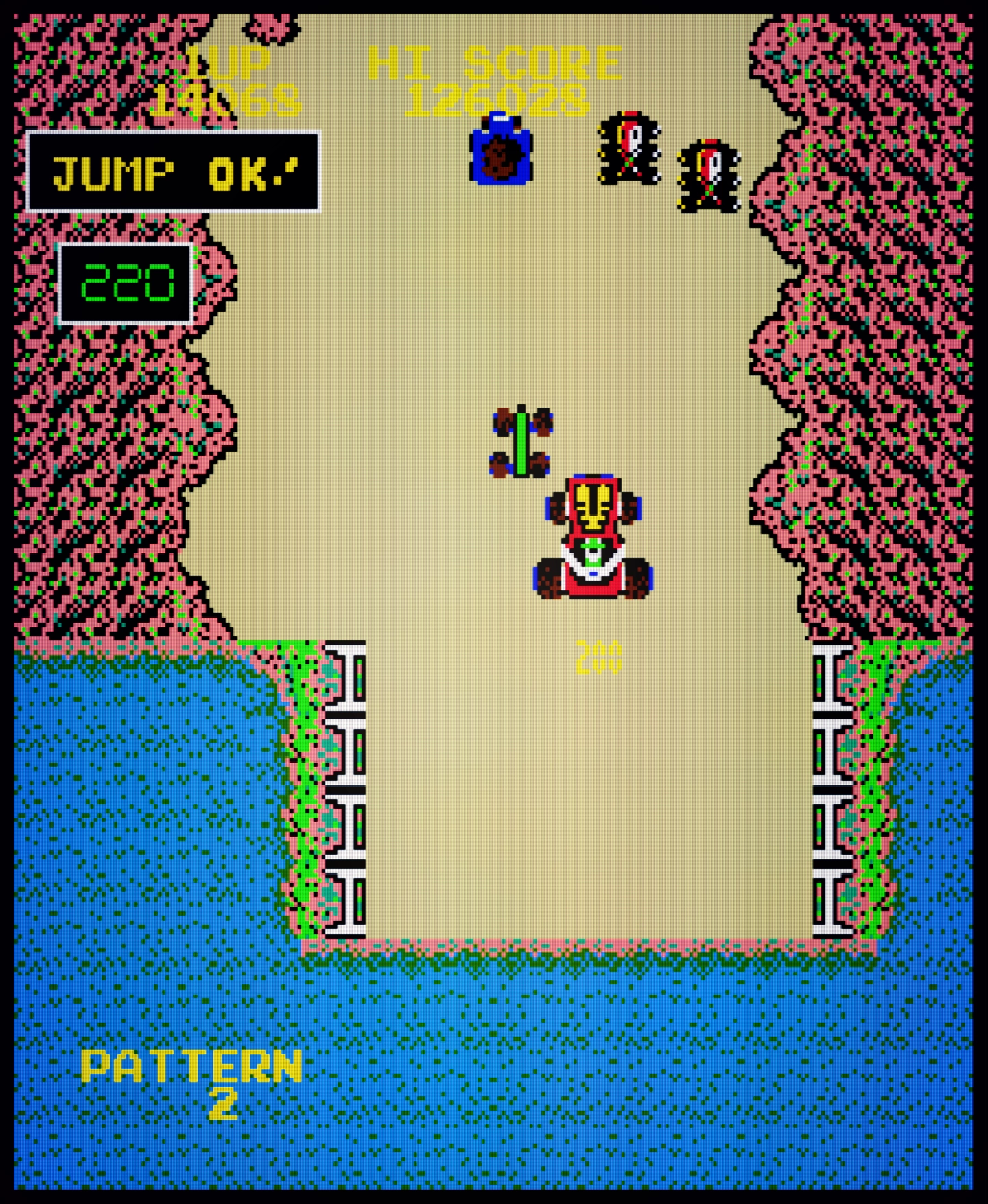
Burnin' Rubber, or Bump 'n' Jump in the US, stored the game on the DECO
audio cassette system, the first standardized way of swapping games in
coin-ops.
Each race is set in one of the four seasons of the year. As Jumpin'
John, your must finish races while scoring points by smashing other cars
- or not smashing any cars at all.
Tension increases at sections where the road narrows or forks, and small
obstacles appear. The most difficult sections are bridges and series of
small islands that require timed jumps.
Sound is rudimentary and graphics are blocky, even for the time. Colors
are garish and sometimes lack contrast.
Yet Burnin' Rubber makes up for it by offering exciting risk-reward
systems and action packed vehicular combat.
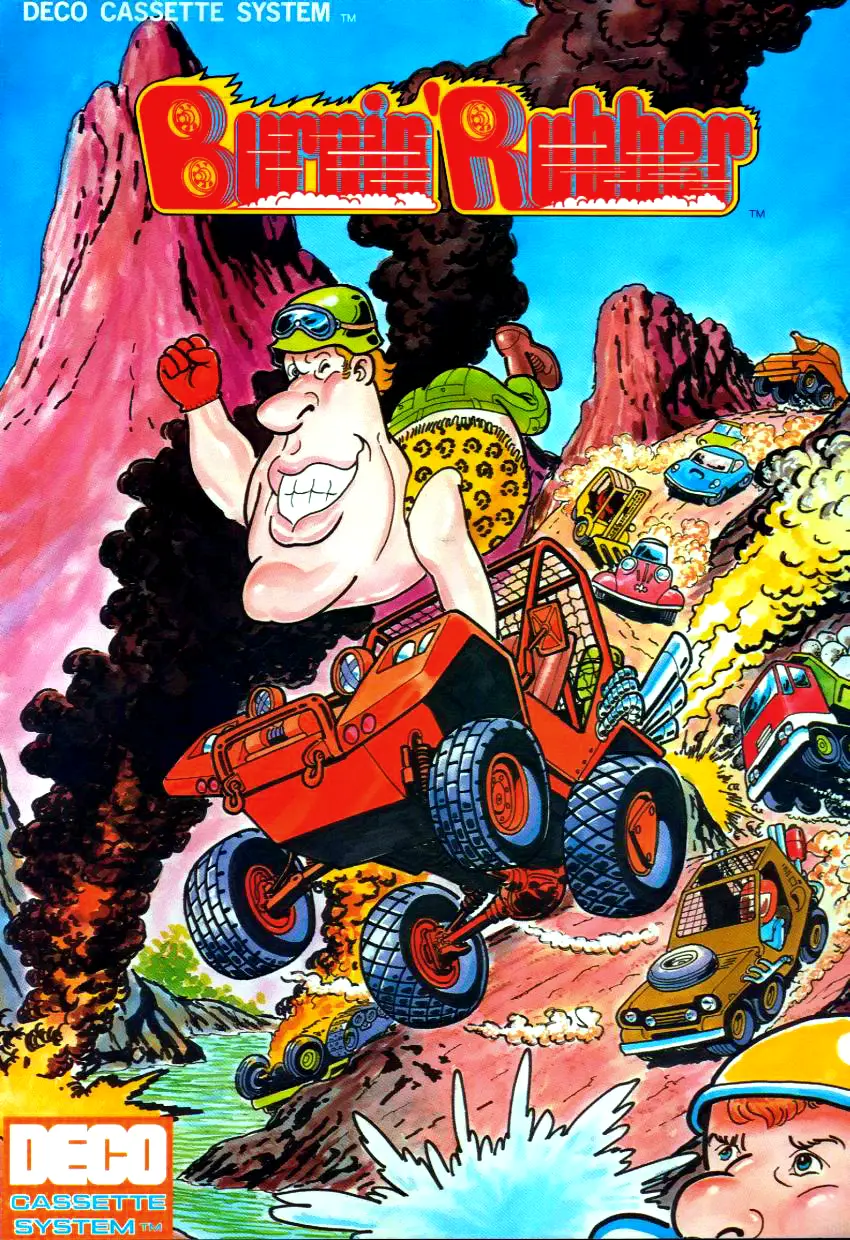
Arcade flyer
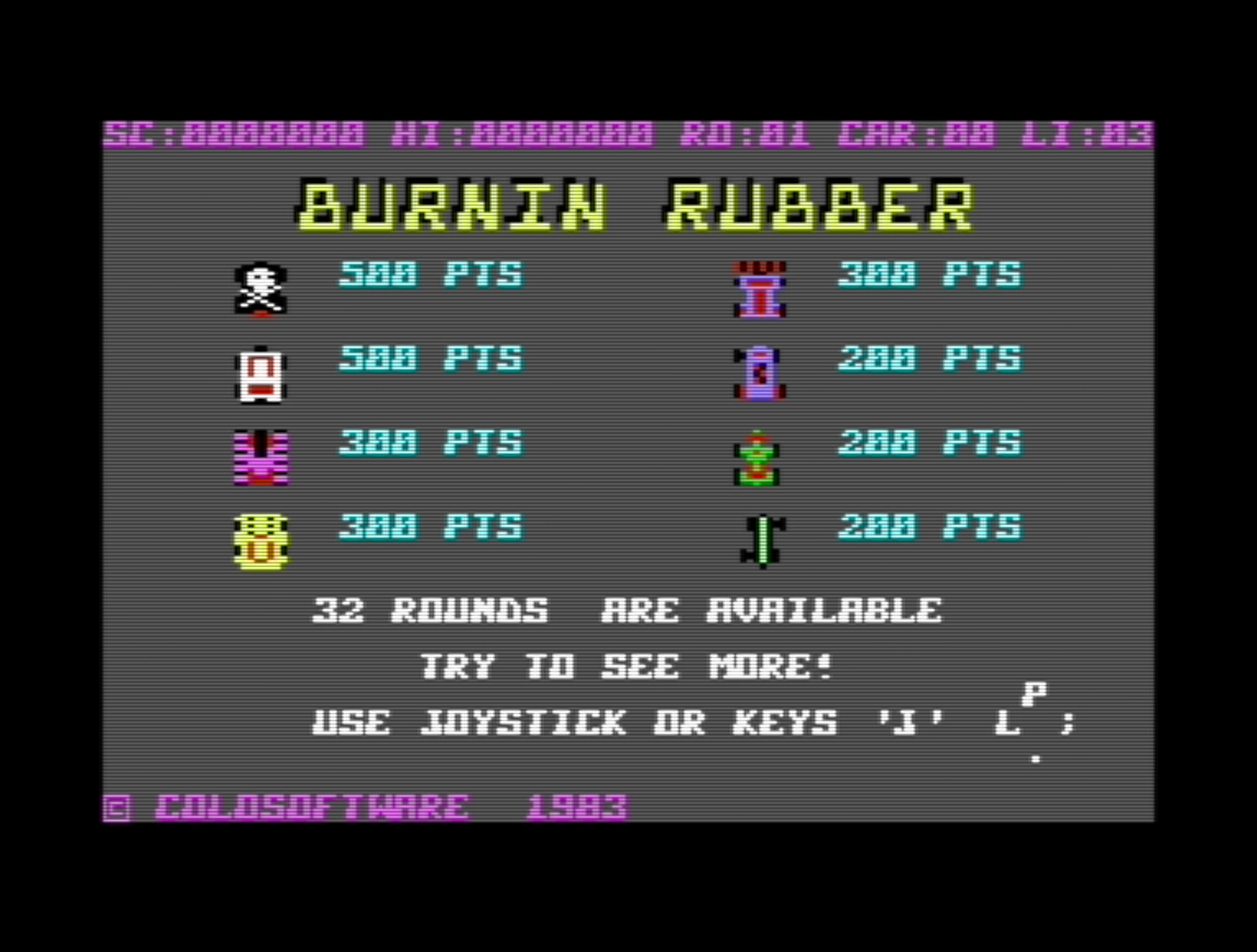
Unlicensed C64 version score table
Opponents range from wooden sticks on wheels to deadly dirt-throwing
dump trucks.
Jump high into the air and land on other cars to smash them, but
risk your own car skidding out.
Sideswiping opponents also cause your own car to skid out, fuelling
fun risk-reward gameplay.
Not destroying any other vehicles at all is much more difficult, but
yields a massive bonus.
The blinking 'JUMP OK!' lights up above 100 mph, so high speed is of
the essence. However, some jumps shouldn't be performed at top speed
or you'll overshoot and crash.
A hidden feature is that you can cross over to the other side of the
screen while jumping.
I first played the unlicensed C64 conversion of Burnin' Rubber by
ColoSoftware (1983). Not a beauty, but very playable.
Bonus info: The background music on the C64 is "Herz und Mund und
Tat und Leben" by J.S. Bach.
My high score on the arcade is
126,028 points.
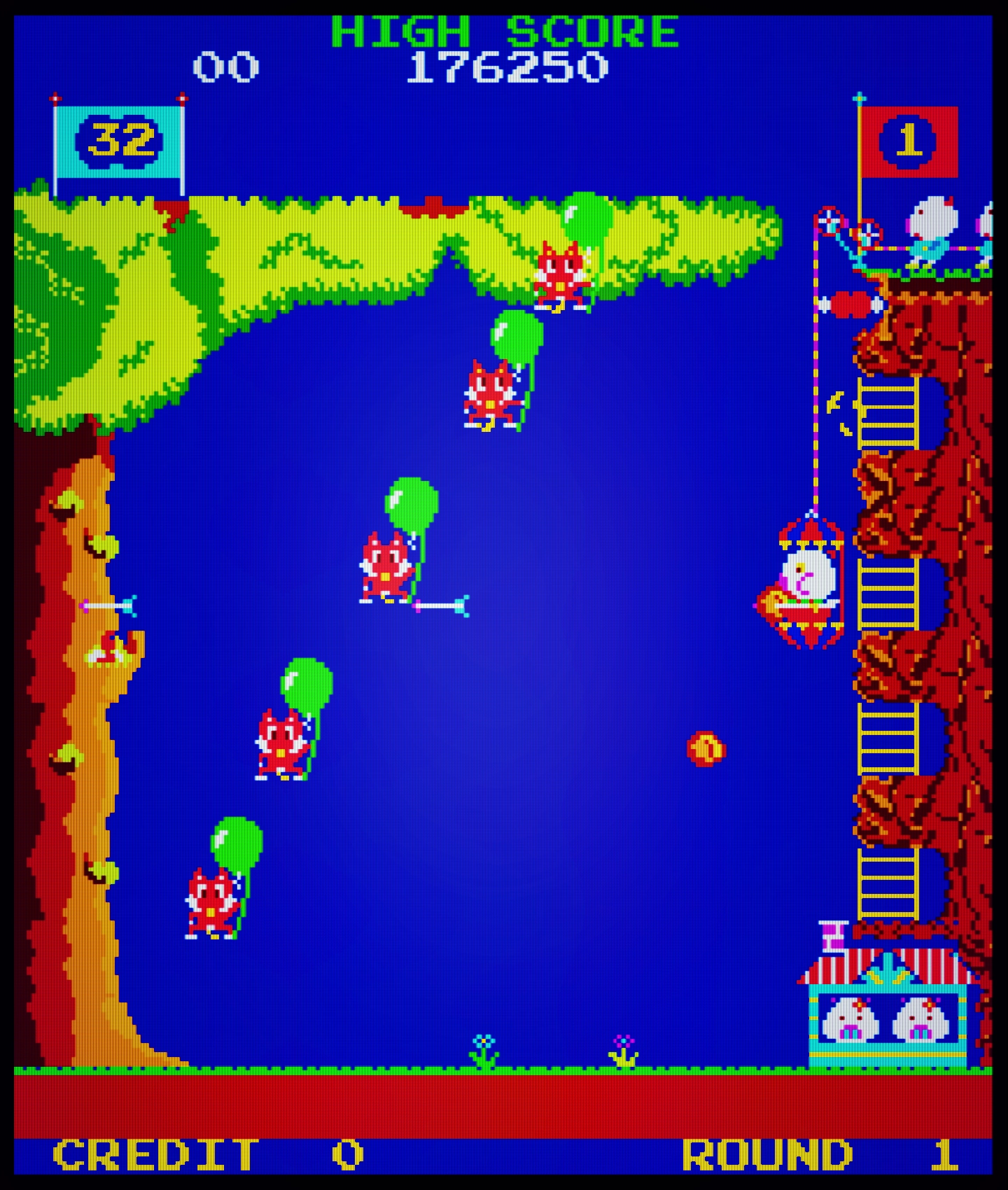
Pooyan was Fujiwara's only game for Konami, instead he defected to
Capcom and directed Ghost'n Goblins, Commando, Tiger Road, and Ghouls'n
Ghosts, as well as producing Resident Evil.
Pooyan, or Pūyan in Japanese, doesn't mean piglets, as incorrectly
translated in the English manual.
Pūyan is a phonetic imitation of inflating something or blowing
air: A reference to the balloons, and the huffing and puffing in The
Three Little Pigs folktale.
Pooyan was released by Konami in Japan while the US machines were
manufactured by Stern Electronic.
The US entertainment and fast-food chain Chuck E. Cheese ordered
machines with their logo and "Made especially for Chuck E. Cheese's
Pizza Time Theatre", although nothing suggests the game design itself
was commissioned by CEC.
The gameplay is fairly unique: In odd stages the player, as Mama Pig,
must prevent balloon-holding, rock-throwing wolves from descending and
biting her.
In even stages the wolves reverse their flight in order to push down a
large boulder on you.
Main stages are interspersed with bonus stages, where you hurl meat for
bonus multipliers or shoot fruit for points.

Arcade marquee
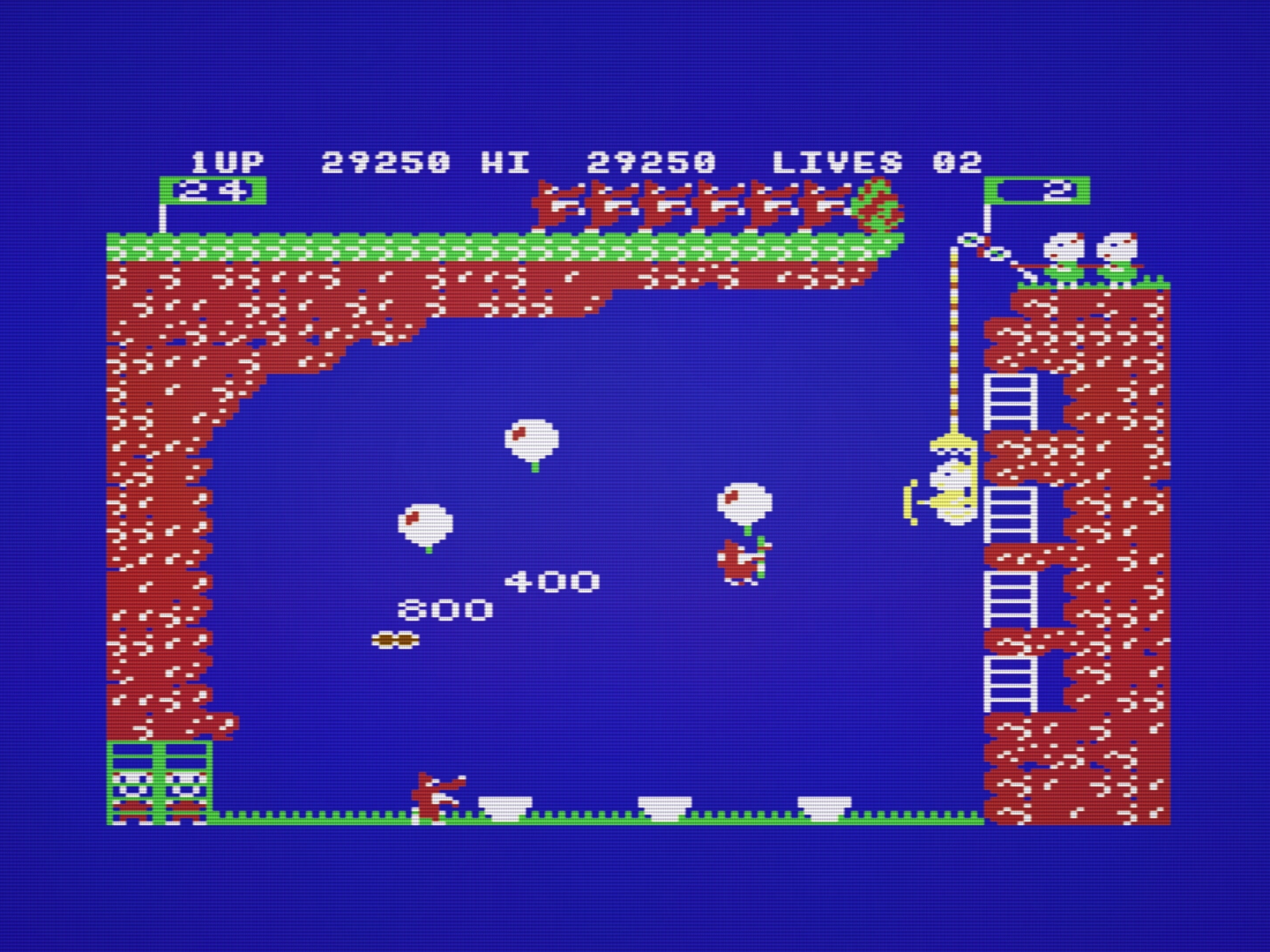
C64 version (DataSoft, 1983)
Hit a group of five wolves with the arced meat shot for the full
points multiplier.
Don't panic if they climb up behind you. Pause between the ladders
and aim at the flying rocks.
In even stages, time the meat shot to avoid lone balloons. Kill the
pink boss wolf or the stage repeats.
The C64 version by Scott Spanburg with graphics by Kelly Day, was a
fine effort.
Some graphics and sounds were re-used in DataSoft's Bruce Lee
(1984).
The catchy and simplistic music is inspired by Antonín
Dvořák's Humoresque Opus 101 Number 7, as well as
various folk ditties.
My high score on the arcade is
176,250.
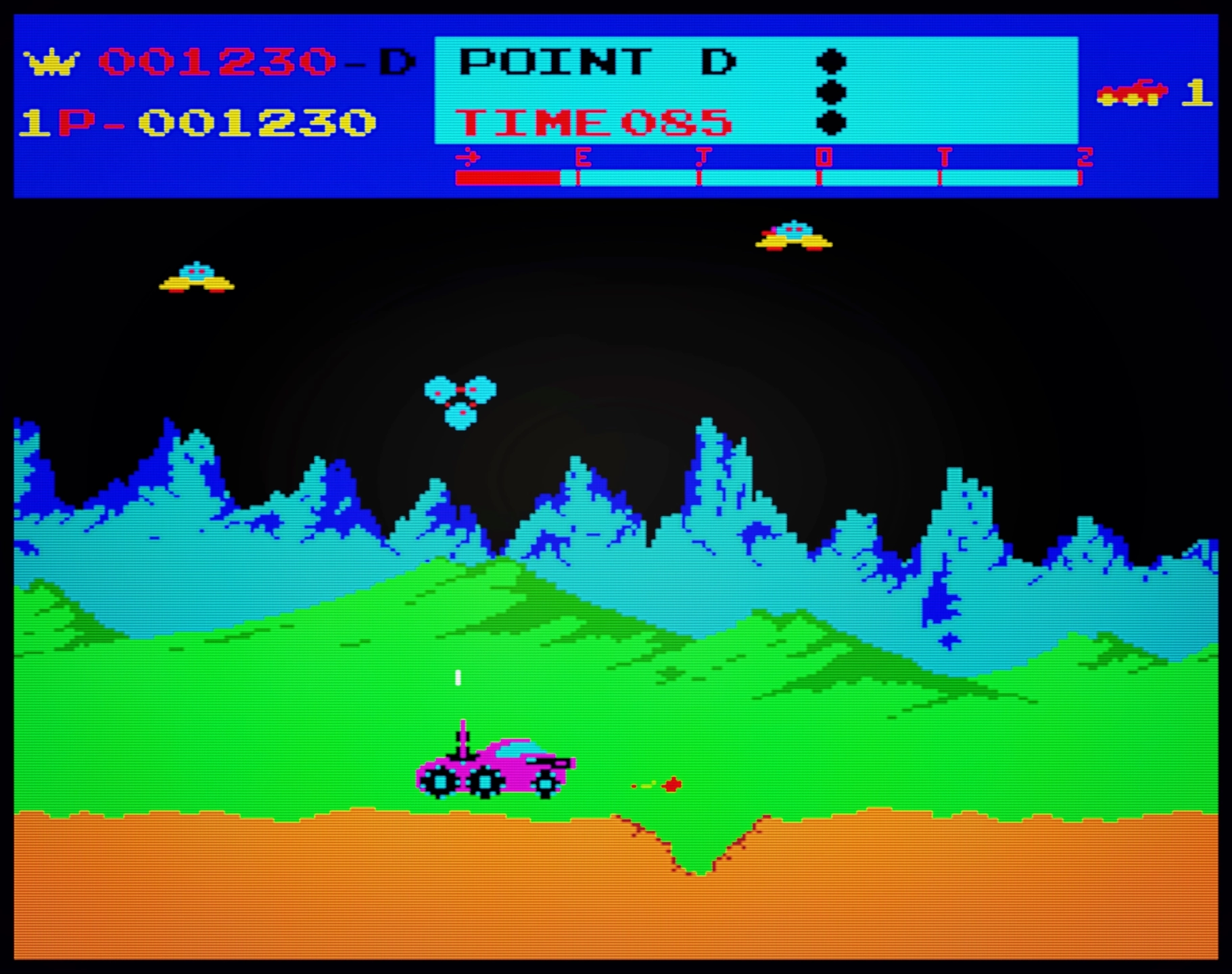
Moon Patrol ranked among the highest-grossing coin-ops in 1983, with US
licensee Williams making around 12,000 units.
You must clear sections by driving as fast as possible to receive a time
bonus. Jump over craters and rock, or shoot rocks with your slow,
forward-facing rockets.
Use your vertical laser to shoot down scores of alien aircrafts
attacking you from the sky. Shoot down flashing bombs or they'll cause a
crater to appear right in front of you.
The bonus motivates fast driving, but inertial acceleration and braking
make timed jumps difficult. Apart from the random movement of the aliens
it's largely a memory and reflex test.
It's renowned for being the first game to feature full parallax
scrolling, a technique where background layers move at different speeds
to create depth perception.
Two years later Takashi Nishiyama followed up with the groundbreaking
beat 'em up Kung-Fu Master. He was also a director on Street Fighter and
a producer on Metal Slug.
Moon Patrol heavily influenced Kung-Fu Master: Continuous background
music (a novelty at the time), side-scrolling, five sections with a time
bonus, and combined jumps and attacks.

Arcade marquee
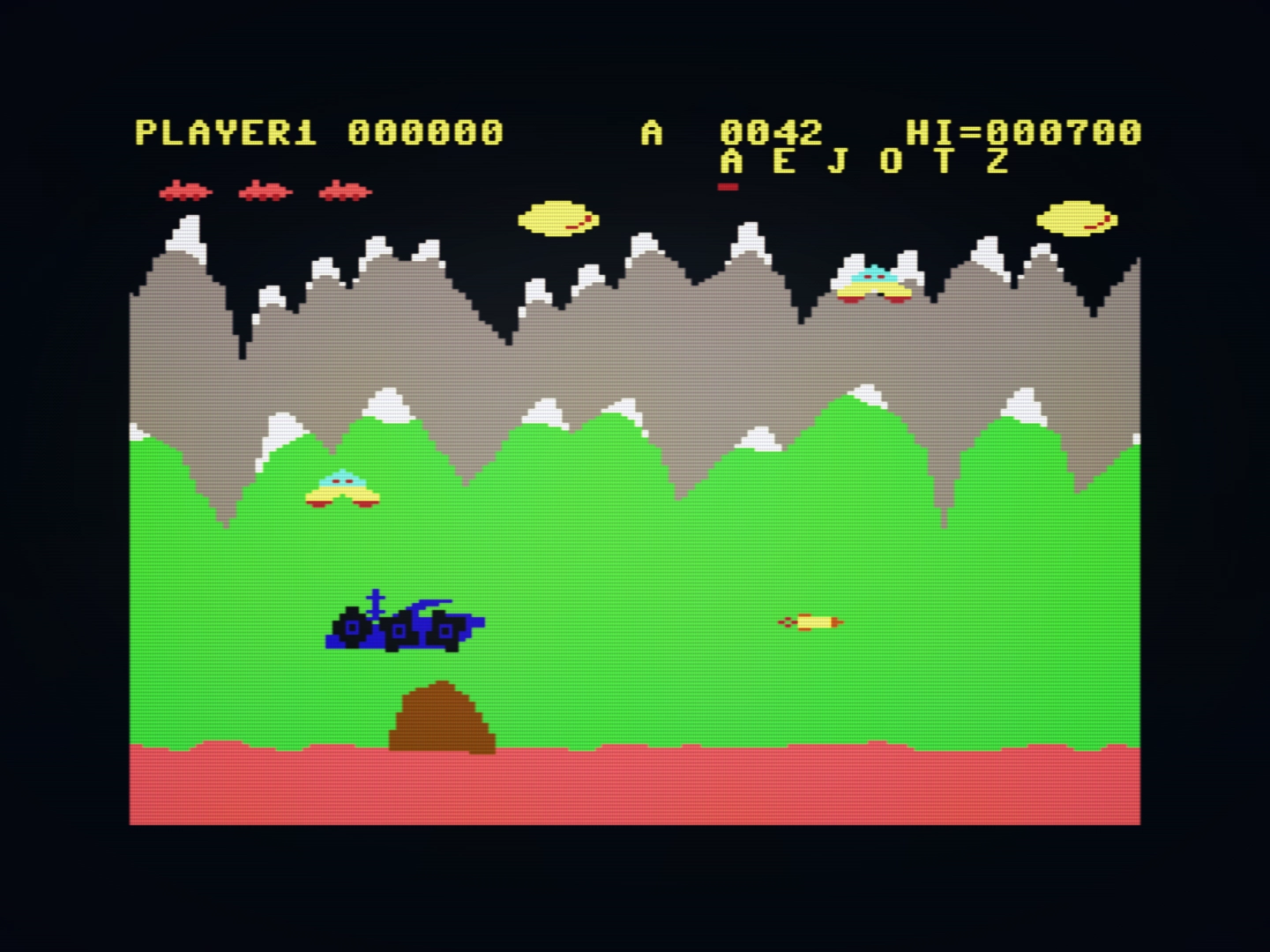
C64 version (Atarisoft, 1983)
My first encounter was the official C64 conversion by Atarisoft from
1983, which retained most of the gameplay and parallax scrolling.
The arcade game was a staple everywhere in Denmark.
Sometimes known as Moon Buggy in cloned versions or as Moon Ranger,
when bootlegged.
There's an obscure official sequel to Moon Patrol called Horizon,
released by Irem in 1985.
Bonus info: The music in Moon Patrol is riffing on the bassline from
James Brown - Soulful Christmas.
Today I'm able to complete all five sections and loop the game, with
a high score of
56,550 points.
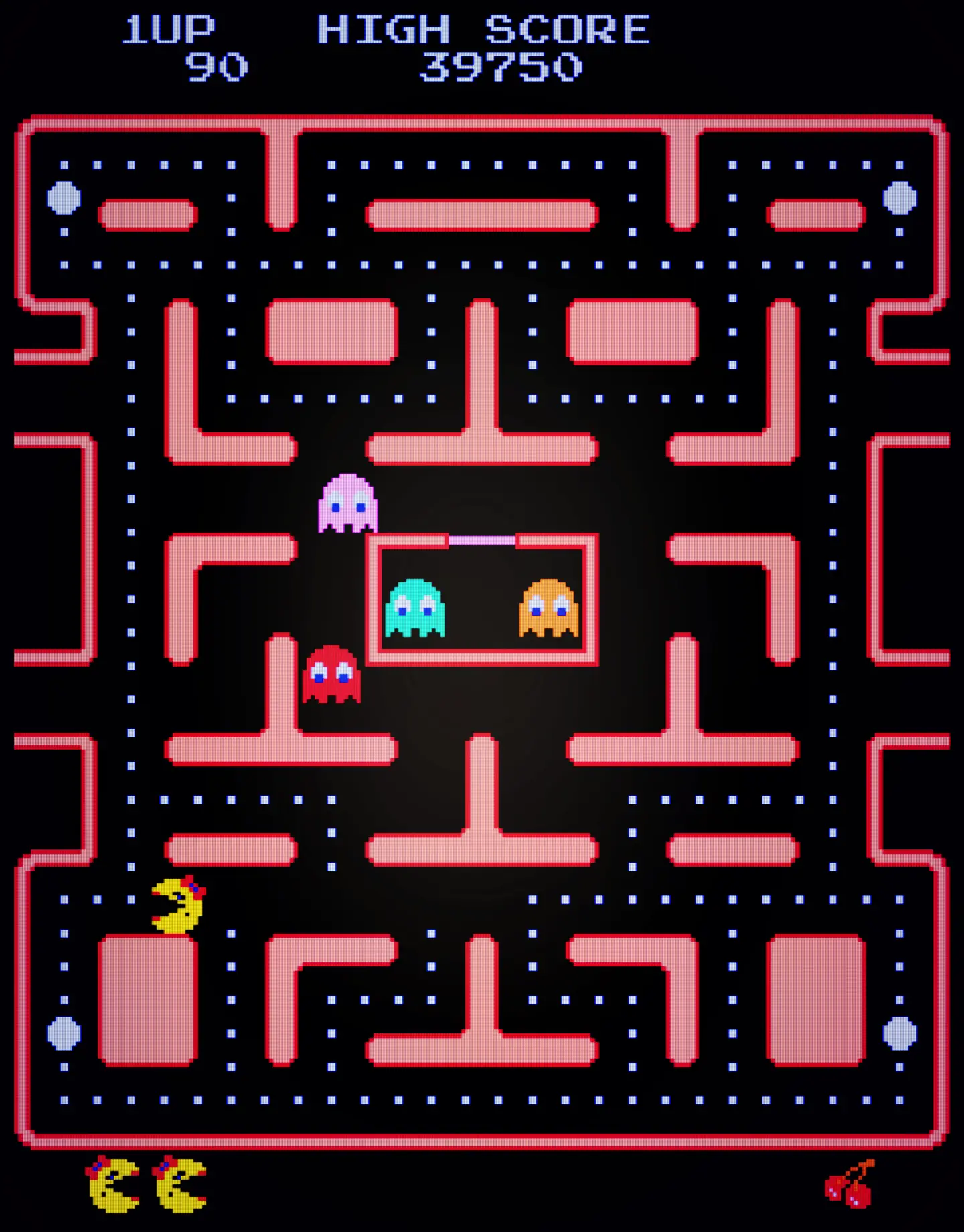
Ms. Pac-Man started out as "Crazy Otto" (1981), an unauthorized
modification kit by GCC for the original Pac-Man (1980) by Namco.
To legalize the game, GCC went to Midway, the US distributor of Pac-Man.
Midway struck a deal with Namco, and this cooperation lead to the
character being swapped from Crazy Otto to Ms. Pac-Man.
Although Toru Iwatani's original design of Pac-Man was groundbreaking,
Ms. Pac-Man is generally recognized as the superior game, much to
Iwatani's chagrin.
Like in Pac-Man, the aim is to eat all the pellets in the maze while
avoiding the ghosts. Eating a power pellet gives you a short duration in
which the roles are reversed. Bonus fruits can be eaten for points.
While you can learn fixed patterns to clear the mazes in Pac-Man, Ms.
Pac-Man requires tactics and faster reactions. Each ghost has a unique
"personality" in the way it gives chase, runs away, or patrols.
With multiple mazes and warp tunnels, better gameplay and visuals -
including some of the earliest examples of cut-scenes - Ms. Pac-Man was
an instant hit.

Crazy Otto character frames

Arcade marquee
I first encountered Ms. Pac-Man in 1984, at the local fast-food
joint in Solrød Beach, Denmark. I would mainly contend with
the respectable C64 version.
40 years later, it's still exciting to munch a power pellet and
gobble blue ghosts - and equally terrifying being chased desperately
around the maze.
The four mazes have specific sections that are safest to clear when
giving chase or if three out of four ghosts are in the opposite part
of the maze:
The top straight of the pink maze, the T-shaped sections in the
light blue maze, the middle and bottom of the orange maze, and just
above and below the ghost generator in the dark blue maze.
Eat power pellets only when you're in a pickle, eat all the bonus
items, and keep going instead of backtracking if you're trapped by
two ghosts.
My high score is
39,750 points.
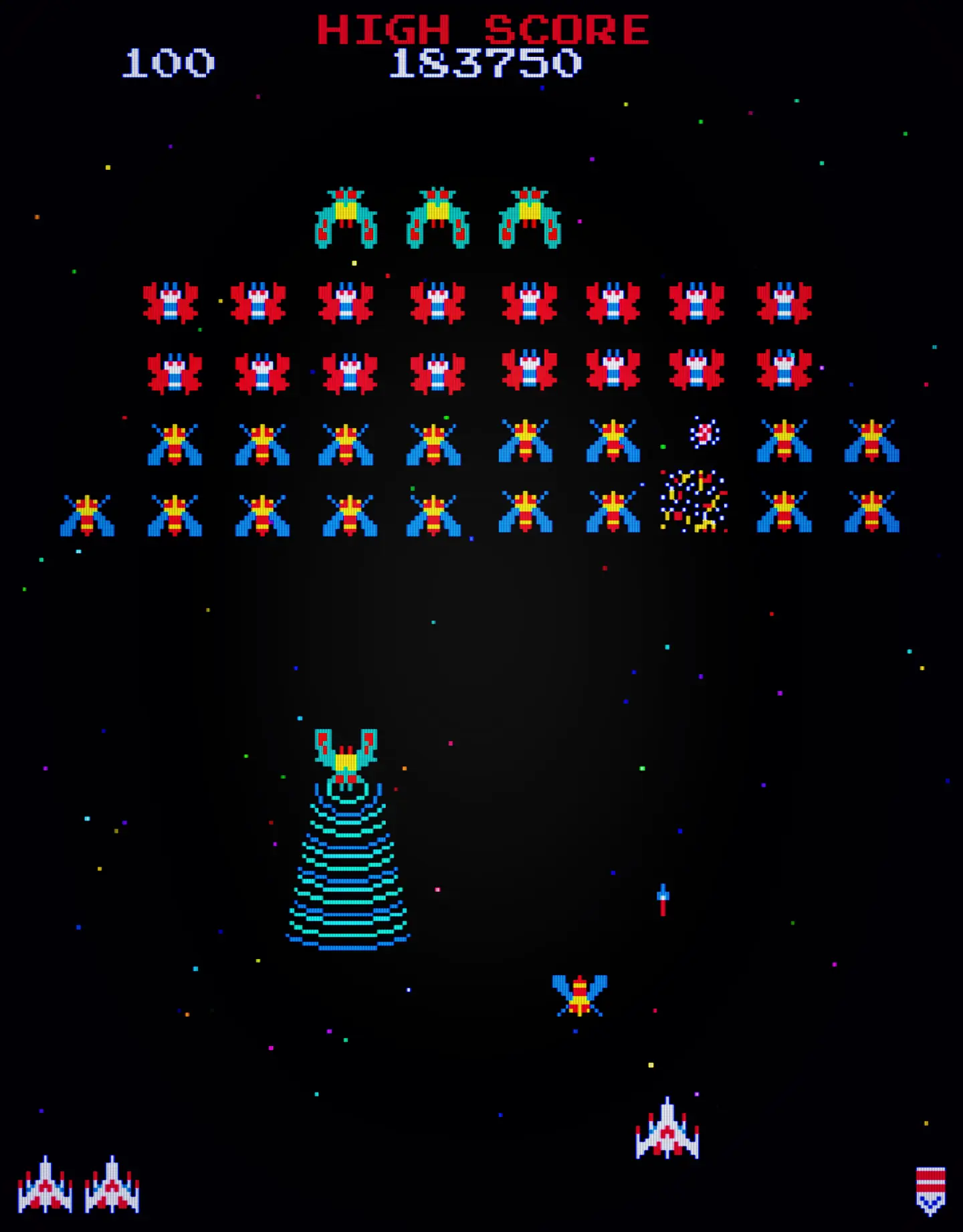
Galaga is considered one of the best arcade games ever. It's the sequel
to Galaxian (1979), in turn inspired by Taito's Space Invaders (1978).
Galaga added unique features to the formula: bonus stages, dual
fighters, and a tractor beam, the idea for which came to designer
Shigeru Yokoyama from a movie he'd seen recently.
Occasionally, a Boss Galaga will swoop down and engage its beam. If your
last fighter is captured, it's game over.
Shoot down the boss when it attacks to re-capture your fighter. This
enables dual fighters: twice the firepower, but twice the risk of being
hit.
The third stage, and every fourth after that, is a 'Challenging Stage':
Shoot as many aliens as possible before they leave the screen. Dual
fighters are required for 100% accuracy.
The bonus stages were inspired by a bug during game development, where
the aliens would stop firing and fly off the screen. Programmer Tetsu
Ogawa proposed this could be used creatively.
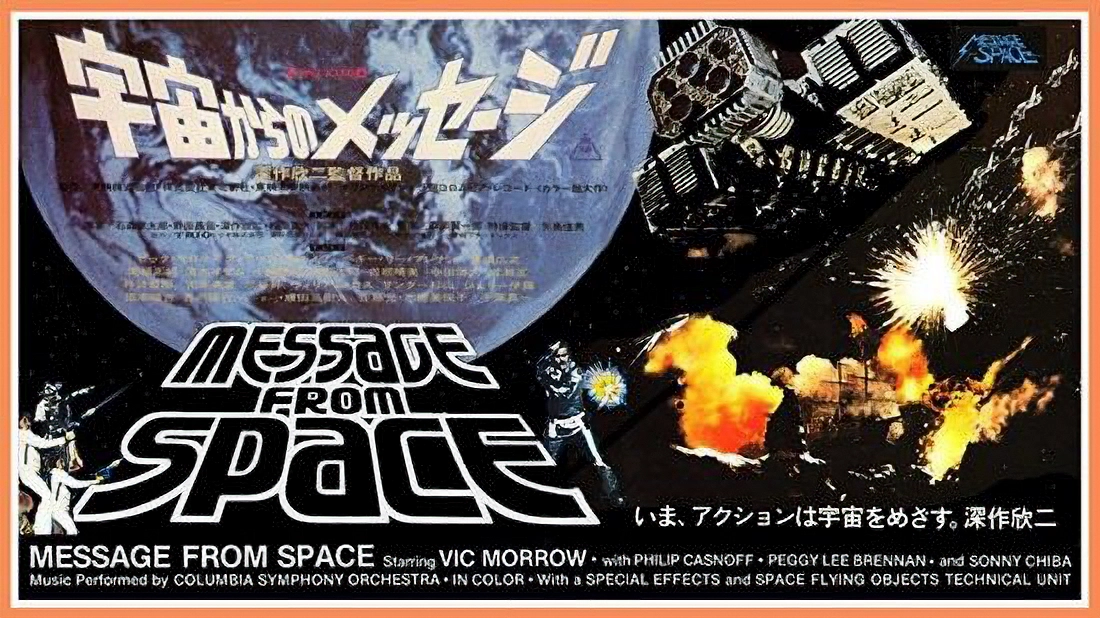
Did Yokoyama watch 'Uchū kara no Messēji' (1978)?

Arcade marquee
The first two bonus stages can be cleared without moving your dual
fighters, by shooting at the 'H' and 'S' in 'HIGH SCORE'.
You only have two shots on screen at any time. Fire with a purpose
or risk being out of shots when an enemy suddenly dives towards you.
A good tactic is to learn the entrance patterns and accurately shoot
the enemies as they enter, rather than when they're in formation.
Early in the game, move your fighters all the way to either side to
avoid being hit. Later in the game, you're more likely to lose your
dual fighter due to increased enemy fire and diving.
Apart from modern conversions, no home version captures the magic of
the original arcade game.
My first engrossing experience with Galaga was at a hotel in
Hammamet in Tunisia in 1987, begging my father for more dinars to
play.
My high score is
183,750 points.